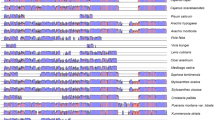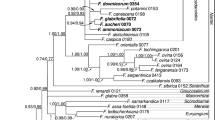Abstract
The RFLP-analysis of PCR amplified cpDNA fragments of 42 representatives of Papaveraceae subfam. Papaveroideae resulted in six most parsimonious cladograms. The subfamily can be divided into a New World group (Arctomecon, Argentone, Canbya, Romneya and Platystemon) and an Old World group (Meconopsis, Papaver s.l. and Roemeria) containing Stylomecon heterophylla and Papaver californicum as New World taxa. In the Old World group neither Meconopsis nor Papaver are monophyletic. Whereas Meconopsis consists of three clades, Papaver comprises five clades, with Roemeria as sister group to P. sect. Argemonidium and Stylomecon as sister group to P. californicum. Various lines of evidence suggest that Meconopsis should be interpreted as a paraphyletic base group of Old World Papaveroideae which gave rise to a polyphyletic Papaver.
Access this chapter
Tax calculation will be finalised at checkout
Purchases are for personal use only
Preview
Unable to display preview. Download preview PDF.
Similar content being viewed by others
References
Aswal, B. S., 1985: Meconopsis bikramii Aswal (Papaveraceae) a new species from Lahul Valley, Himachal Pradesh, India. — Indian J. Forest. 8: 84–85.
Bentham, G., 1835: Meconopsis heterophylla. — Trans. Hort. Soc. London, ser. 2, 1: 408.
Biswas, K., 1966: Plants of Darjeeling and the Sikkim Himalayas. — Alipore: West Bengal Government Press.
Blunt, W., 1976: Poppycock: The blue poppies. — Garden (London) 101: 211–212.
Brückner, C., 1982: Zur Kenntnis der Fruchtmorphologie der Papaveraceae Juss. s. str. und der Hypecoaceae (Prantl ex Kündig) Nak. — Feddes Repert. 93: 153–212.
Candolle, A. P. De, 1824: Papaveraceae. — Prodromus systematis naturalis regni vegetabilis, 1, pp. 117–124.
Castroviejo, S., Laínz, M., López González, G., Montserrat, P., Munos Garmendia, F., Paiva, J., Villar, L., (Eds): 1986: Flora Iberica 1: Lycopodiaceae-Papaveraceae. — Madrid: Real Jardín Botánico, C.S.I.C.
Chuang, Hsuan, 1981: The systematic evolution and geographical distribution of Meconopsis. — Proceedings of Symposium on Qinghai-Xizang (Tibet) Plateau (Beijing, China), 2. Environment and ecology of Qinghai-Xizang Plateau, pp. 1263–1268. — Beijing: Science Press; New York: Gordon and Breach.
Debnath, H. S., Nayar, M. P., 1989: A new species of Meconopsis Vig. (Papaveraceae) from Nepal. — J. Japan. Bot. 64: 157–159.
Derbyshire, E., 1992: Origine et remise en cause de la théorie des glaciations pléistocènes de la Chine du Sud-Est: le cas des massifs de Lushan et Huangshan. — Ann. Géogr. 566: 472–490.
Ernst, W. R., 1962: A comparative morphology of the Papaveraceae. — Ph.D. Thesis, Stanford University.
Fairbairn, J. W., Williamson, E. M., 1978: Meconic acid as a chemotaxonomic marker in the Papaveraceae. — Phytochemistry 17: 2087–2089.
Feng, Kuo Mei, 1979: Meconopsis wumungensis K. M. Feng sp. nov. — In Wu, Cheng Yih, (Ed.): Flora Yunnanica, 2, p. 33. — Beijing: Academia Sinica Press.
Grey-Wilson, C., 1993: Poppies. — Portland, Oregon: Timber Press.
Grierson, A. J. C., Long, D. G., 1984: Flora of Bhutan, 1, 2. — Edinburgh: Royal Botanic Garden.
Hanelt, P., 1969: Revision der mongolischen Taxa von Papaver L. sect. Scapiflora Rchb. sowie Studien zur Systematik und Evolution dieser Sektion. — Habil. Gatersleben.
Hara, H., 1966, (Ed.): The flora of Eastern Himalaya. — Tokyo: The University of Tokyo Press.
Harborne, J. B., 1967: Comparative biochemistry of the flavonoids. — London, N. Y: Academic Press.
Hooker, J. D., 1851: Cathcartia villosa. — Bot. Mag. Ser. 3, Vol. VII, (Vol. 77 of all), table 4596.
Hsieh, Chiao min, Salter, C. L., 1973: Atlas of China. — New York: McGraw-Hill.
Jalas, J., Suominen, J., (Eds), 1991: Atlas Florae Europaeae 9. Paeoniaceae to Capparaceae. — Helsinki: Helsinki University Printing House.
Kadereit, J. W., 1988a: Sectional affinities and geographical distribution in the genus Papaver L. (Papaveraceae). — Beitr. Biol. Pfl. 63: 139–156.
— 1988b: The affinities of the south-hemispherical Papaver aculeatum Thunb. (Papaveraceae). — Bot. Jahrb. Syst. 109: 335–341.
— 1993: Papaveraceae. — In Kubitzki, K., Rohwer, J. G., Bittrich, V., (Eds): The families and genera of vascular plants, 2, pp. 494–506. — Berlin, Heidelberg: Springer.
— Sytsma, K. J., 1992: Disassembling Papaver: a restriction site analysis of chloroplast DNA. — Nordic J. Bot. 12: 205–217.
— Blattner, F. R., Jork, K. B., Schwarzbach, A., 1994: Phylogenetic analysis of the Papaveraceae s.l. (incl. Fumariaceae, Hypecoaceae, and Pteridophyllum) based on morphological characters. — Bot. Jahrb. Syst. 116: 361–390.
Löve, A., 1977: IOPB Chromosome number reports L VII. — Taxon 26: 445.
Maddison, W. P., Maddison, D. R., 1992: MacClade. Analysis of phylogeny and character evolution, version 3. — Sunderland, Mass.: Sinauer.
Maude, P., 1940: Chromosome numbers in some British plants. — New Phytol. 39: 17–32.
Meusel, H., Schubert, R., 1971: Beiträge zur Pflanzengeographie des Westhimalayas 1. Teil: Die Arealtypen. — Flora 160: 137–194.
— Jäger, E., Weinert, E., 1965: Vergleichende Chorologie der zentraleuropäischen Flora. Karten, I. — Jena, Stuttgart, New York: G. Fischer.
— 1978: Vergleichende Chorologie der zentraleuropäischen Flora, Karten, II.-Jena: G. Fischer.
Prain, D., 1895: Noviciae Indicae IX. — J. Asiat. Soc. Bengal. 64: 303–327.
— 1906: A review of the genera Meconopsis and Cathcartia. — Ann. Bot. (Oxford) 20: 323–370.
Price, J. R., Robinson, R., Scott-Moncrieff, R., 1939: The yellow pigment of Papaver nudicaule. Part 1. — J. Chem. Soc. (London): 1465–1468.
Rao, M. A., 1974: Chapter 10. Vegetation and phytogeography of the Himalaya. — In Mani, M. S., (Ed.): Ecology and biogeography in India. — The Hague: Junk.
Ratter, J. A., 1968: Cytological studies in Meconopsis. — Notes Roy. Bot. Gard. Edinburgh 28: 191–200.
Raven, P. H., Axelrod, D. I., 1974: Angiosperm biogeography and past continental movements. — Ann. Missouri Bot. Gard. 61: 539–673.
Schwarzbach, A., Kadereit, J. W., 1995: Rapid radiation of North American desert genera of the Papaveraceae: evidence from restriction site mapping of PCR-amplified chloroplast DNA fragments. — Pl. Syst. Evol. [Suppl.] 9: 159–170.
Stebbins, G. L., Major, J., 1965: Endemism and speciation in the California flora. — Ecol. Monogr. 35: 1–35.
Swofford, D. L., 1993: PAUP: Phylogenetic analysis using parsimony, ver. 3.1.1-Computer program distributed by the Illinois Natural History Survey, Champaign, Ill.
Taylor, G., 1934: An account of the genus Meconopsis. — London: New Flora & Silva.
Viguier, L. G. A., 1814: Histoire naturelle, médicale et économique, des pavots et des argémones. — Dissertation Montpellier.
Williams, L. H. J., 1972: Meconopsis taylorii, a new species from Nepal. — Trans. Bot. Soc. Edinburgh 41: 347–349.
Wissmann, H. von, 1959: Die heutige Vergletscherung und Schneegrenze in Hochasien mit Hinweisen auf die Vergletscherung der letzten Eiszeit. — Akad. Wiss. Mainz, Abh. Math. — Naturwiss. Kl. 14: 1101–1431.
Wu, Cheng Yih, Chuang, Hsuan, 1985: Meconopsis pseudohorridula C. Y. Wu et H. Chuang sp. nov. — In Wu, Cheng Yih, (Ed.): Flora Xizangica, 2, p. 234. — Kunming: Science Press.
Zhou, Li Hua, 1979: New taxa of Meconopsis from Qinghai-Tibet Plateau. — Acta Phytotax. Sin 17: 112–114.
— 1980: Study on the Meconopsis of Qinghai-Tibet Plateau. — Bull. Bot. Lab. N. E. Forest. Inst., Harbin 8: 91–101.
Author information
Authors and Affiliations
Editor information
Editors and Affiliations
Rights and permissions
Copyright information
© 1995 Springer-Verlag Wien
About this paper
Cite this paper
Jork, K.B., Kadereit, J.W. (1995). Molecular phylogeny of the Old World representatives of Papaveraceae subfamily Papaveroideae with special emphasis on the genus Meconopsis . In: Jensen, U., Kadereit, J.W. (eds) Systematics and Evolution of the Ranunculiflorae. Plant Systematics and Evolution Supplement 9, vol 9. Springer, Vienna. https://doi.org/10.1007/978-3-7091-6612-3_15
Download citation
DOI: https://doi.org/10.1007/978-3-7091-6612-3_15
Publisher Name: Springer, Vienna
Print ISBN: 978-3-7091-7361-9
Online ISBN: 978-3-7091-6612-3
eBook Packages: Springer Book Archive




